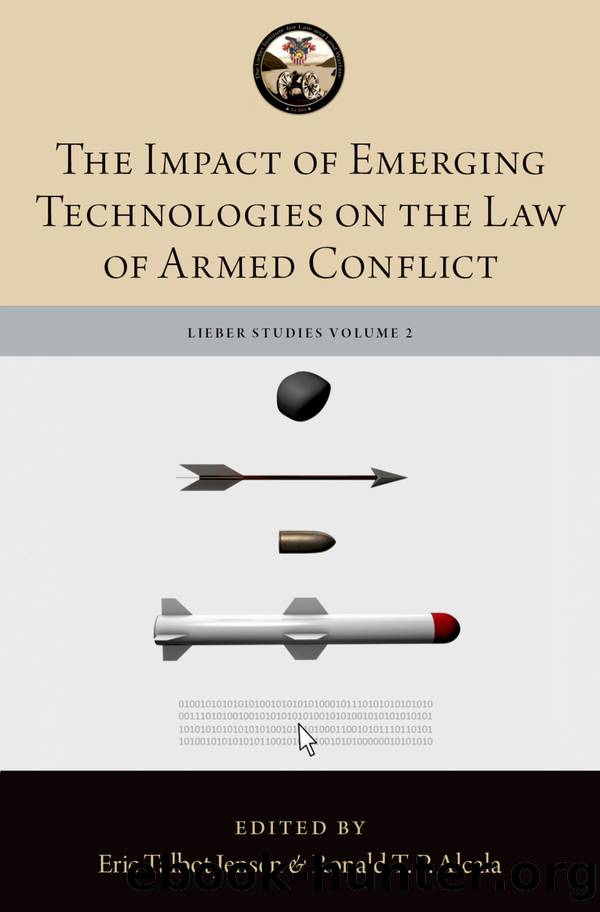The Impact of Emerging Technologies on the Law of Armed Conflict by Alcala Ronald T. P.; Jensen Eric Talbot;

Author:Alcala, Ronald T. P.; Jensen, Eric Talbot;
Language: eng
Format: epub
Publisher: Oxford University Press USA - OSO
Published: 2019-07-15T00:00:00+00:00
B. How the DOD Reconciles the Perspectives
The DOD recognizes the interplay of the LOAC and contracting perspectives. For instance, DODI 1100.22 specifically notes restrictions in hostile environments, to include those from the LOAC or international agreements.142 It states that “civilians accompanying the armed force may be directly targeted for such time as they take a direct part in hostilities but, if captured, do not lose their entitlement to POW status.”143 And, beyond mere recognition of the issue, the DOD seeks to affirmatively reconcile the possible disconnect between how the United States regards its own civilians versus those of its adversaries—through the assertion of State’s inherent authority.
For combatants, the United States regards their immunity from prosecution for the conduct of hostilities as derivative of State sovereignty; it is a right of the State, extended to the agents thereof.144 Under this view, “the combatant’s privilege requires that combatants act under the commission of a belligerent State,” and this commission is the sole source for such immunity.145
A similar, though less overt, view is taken in the Manual for civilians accompanying the armed forces. For instance, it states that “[p]ersons authorized to accompany the armed forces should not engage in unauthorized participation in hostilities. Such activity would be treated like engagement in private acts of hostility, and such persons would be in the position of unprivileged belligerents in relation to those activities.”146 So, the line between legitimate conduct and unprivileged belligerency is the authorization from the sending State. This is consistent with the United States’ commensurate rejection of both combatant immunity and traditional “civilian” protections for non-State organized armed groups, because like individuals directly participating, they lack State authority.147 Again, State endorsement or authorization (an impossibility for most nonstate armed groups) is the key factor. This view is reflected in U.S. criminal jurisprudence as well:
Importantly, this lawful combatant immunity is not automatically available to anyone who takes up arms in a conflict. Rather, it is generally accepted that this immunity can be invoked only by members of regular or irregular armed forces who fight on behalf of a state and comply with the requirements for lawful combatants.148
Download
This site does not store any files on its server. We only index and link to content provided by other sites. Please contact the content providers to delete copyright contents if any and email us, we'll remove relevant links or contents immediately.
The Pirates of Somalia by Jay Bahadur(1544)
Political Theology by Carl Schmitt(1504)
The Holocaust: A New History by Laurence Rees(1447)
The Social Animal by David Brooks(1361)
A Practical Guide to International Arbitration in London by Hilary Heilbron(1347)
Restitution by Restitution(1331)
Pirates of Somalia by Jay Bahadur(1305)
Coercing Virtue by Robert H. Bork(1267)
The Nuremberg Interviews by Leon Goldensohn(1210)
Basic International Corporate Taxation by Sebastiano Garufi(1127)
A History Of Thailand by Baker Chris(1100)
The Global Commons by Susan J. Buck(1065)
Asian Waters by Humphrey Hawksley(1061)
International Trade and Business: Law, Policy and Ethics by Gabriël Moens & Peter Gillies(1058)
Blood Profits by Vanessa Neumann(1047)
Spring Fever: The Illusion of Islamic Democracy by McCarthy Andrew C(1043)
The Sovereignty of Human Rights by Macklem Patrick(1007)
The Nuremberg Trials: The Nazis and their Crimes Against Humanity by Roland Paul(986)
Crimes Against Humanity: Historical Evolution and Contemporary Application by M. Cherif Bassiouni(964)
